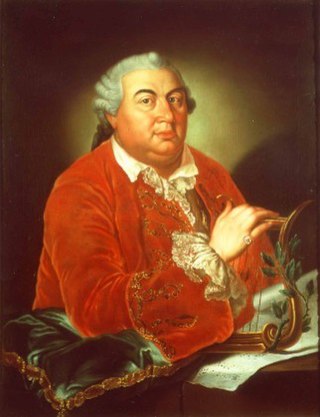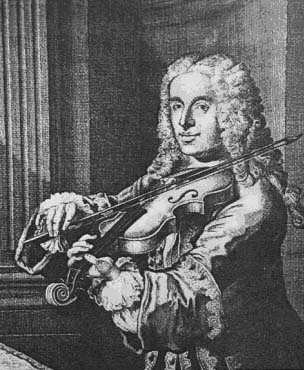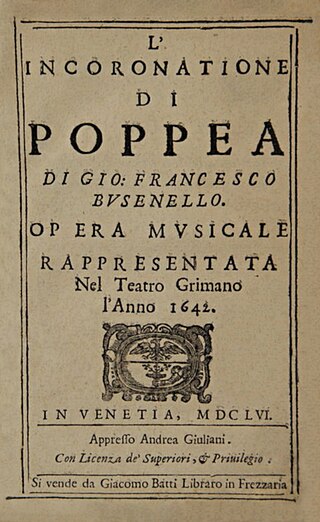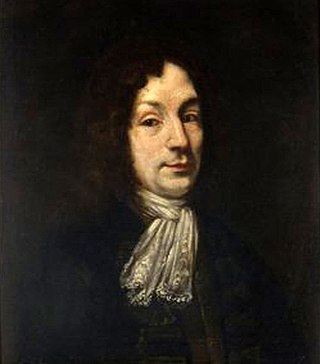
Francesco Cavalli was a Venetian composer, organist and singer of the early Baroque period. He succeeded his teacher Claudio Monteverdi as the dominant and leading opera composer of the mid 17th-century. A central figure of Venetian musical life, Cavalli wrote more than forty operas, almost all of which premiered in the city's theaters. His best known works include Ormindo (1644), Giasone (1649) and La Calisto (1651).

Niccolò Jommelli was an Italian composer of the Neapolitan School. Along with other composers mainly in the Holy Roman Empire and France, he was responsible for certain operatic reforms including reducing ornateness of style and the primacy of star singers somewhat.

Pietro Alessandro Guglielmi was an Italian opera composer of the classical period.

Francesco Maria Veracini was an Italian composer and violinist, perhaps best known for his sets of violin sonatas. As a composer, according to Manfred Bukofzer, "His individual, if not subjective, style has no precedent in baroque music and clearly heralds the end of the entire era", while Luigi Torchi maintained that "he rescued the imperiled music of the eighteenth century", His contemporary, Charles Burney, held that "he had certainly a great share of whim and caprice, but he built his freaks on a good foundation, being an excellent contrapuntist". The asteroid 10875 Veracini was named after him.

Giuseppe Gazzaniga was a member of the Neapolitan school of opera composers. He composed fifty-one operas and is considered to be one of the last Italian opera buffa composers.

L'incoronazione di Poppea is an Italian opera by Claudio Monteverdi. It was Monteverdi's last opera, with a libretto by Giovanni Francesco Busenello, and was first performed at the Teatro Santi Giovanni e Paolo in Venice during the 1643 carnival season. One of the first operas to use historical events and people, it describes how Poppaea, mistress of the Roman emperor Nero, is able to achieve her ambition and be crowned empress. The opera was revived in Naples in 1651, but was then neglected until the rediscovery of the score in 1888, after which it became the subject of scholarly attention in the late 19th and early 20th centuries. Since the 1960s, the opera has been performed and recorded many times.

L'Ormindo is an opera in a prologue and three acts by Francesco Cavalli to an original Italian libretto by Giovanni Faustini. The manuscript score is held at the Biblioteca Marciana in Venice, while a copy of the original libretto has been digitized by the Library of Congress. The opera has set numbers with recitative, and is set in Anfa (Casablanca), in the Mauri kingdom of Fessa (Fez).

The Teatro San Cassiano was the first public opera theatre in Venice, inaugurated as such in 1637. The first mention of its construction dates back to 1581. The name with which it is best known comes from the parish in which it was located, San Cassiano, in the Santa Croce district (‘sestiere’) not far from the Rialto.

Didone is an opera by Francesco Cavalli, set to a libretto by Giovanni Francesco Busenello. The opera was first performed at Venice's Teatro San Cassiano during 1640.

Erismena is an opera in a prologue and three acts by Francesco Cavalli. First performed in Venice in 1655, it was designated as a dramma per musica.

Ciro (Cyrus) is an opera in three acts and a prologue by the Italian composer Francesco Cavalli in collaboration with Andrea Mattioli. It was first performed at the Teatro San Giovanni e San Paolo, Venice on January 30, 1654. The libretto is by Giulio Cesare Sorrentino in a revised version by Aurelio Aureli. Sorrentino's libretto had been set the previous year by Francesco Provenzale for the royal theatre in Naples.

Artemisia is an opera in three acts and a prologue by the Italian composer Francesco Cavalli from a libretto written by Nicolò Minato. It was first performed at the Teatro San Giovanni e San Paolo, Venice on 10 January 1657 and revived in Naples in 1658, Palermo in 1659, Milan in 1663 and Genoa in 1665.

Doriclea is an opera in three acts and a prologue by the Italian composer Francesco Cavalli with a libretto by Giovanni Faustini. It was first performed at the Teatro San Cassiano, Venice in 1645.

Rosinda, also known as La Rosinda, is an opera in three acts and a prologue by the Italian composer Francesco Cavalli with a libretto by Giovanni Faustini. It was first performed at the Teatro Sant 'Apollinare, Venice in 1651-02 during Carnival. It appears to have been better received than La Calisto, which was also premiered that year, and was revived in Naples and/or Florence in 1653 under the title Le magie amorose.

Argippo is an opera libretto by Domenico Lalli, which in Giovanni Porta's setting premiered in Venice in 1717. Claudio Nicola Stampa's reworked version of the libretto was set as L'Argippo by Andrea Stefano Fiorè. This opera was performed in Milan in 1722.

Carlo Francesco Pollarolo was an Italian composer, organist, and music director. Known chiefly for his operas, he wrote a total of 85 of them as well as 13 oratorios. His compositional style was initially indebted to the opera tradition of Giovanni Legrenzi and Carlo Pallavicino, but he moved beyond this style with innovations to the compositional structure of the aria characterized by expanded forms and orchestral elaborations. His early work used three part strings in the Legrenzi and Pallacino tradition of orchestration, but his mid and later works had developed into a richer orchestration of five strings parts and expanded instrumentation of brass and woodwinds. He was the first Venetian opera composer and one of the earliest Italian composers to use the oboe in his opera orchestrations.

Catone in Utica is an opera libretto by Metastasio, that was originally written for Leonardo Vinci's 1727 opera. Following Vinci's success, Metastasio's text was used by numerous composers of the baroque and classical eras for their own operas, including Pietro Torri (1736), Antonio Vivaldi (1737), Giovanni Battista Ferrandini (1753) and J. C. Bach (1761).

The Accademia degli Incogniti, also called the Loredanian Academy, was a learned society of freethinking intellectuals, mainly noblemen, that significantly influenced the cultural and political life of mid-17th century Venice. The society was founded in 1630 by Giovanni Francesco Loredan and Guido Casoni, and derived its basic Aristotelian philosophy from Cesare Cremonini, a Peripatetic who was a professor of philosophy at the University of Padua. The society included historians, poets, and librettists.
Fortunato Chelleri was a Baroque Kapellmeister and composer.

Luca Antonio Predieri was an Italian composer and violinist. A member of a prominent family of musicians, Predieri was born in Bologna and was active there from 1704. In 1737 he moved to Vienna, eventually becoming Kapellmeister to the imperial Habsburg court in 1741, a post he held for ten years. In 1765 he returned to his native city where he died two years later at the age of 78. A prolific opera composer, he was also known for his sacred music and oratorios. Although his operas were largely forgotten by the end of his own lifetime and most of their scores lost, individual arias as well some of his sacred music are still performed and recorded.












